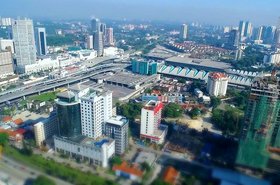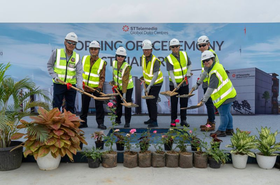Johor, the southernmost state on the Malaysian peninsula, has historically been associated with rubber and oil palm plantations. But in recent years, it has gained a new reputation as one of the world’s fastest-growing data center markets.
It helps to get a sense of the facts and figures. Real estate consultancy CBRE says Malaysia possesses the biggest pipeline of data center developments in Southeast Asia. Cushman and Wakefield concurs. A July 2025 report written by DC Byte, a data center consultancy, states that Johor currently offers around 487MW in live capacity; contains 324MW worth of projects under construction; is home to 1.4GW worth of committed projects – referring to developments which have secured all necessary elements like energy and land but have not begun construction – and, most stunningly, has 3.4GW of early stage projects, which refers to data centers which have secured some, but not all, of the required elements for construction.
Compare this to Singapore, which is separated from Johor’s state capital, Johor Bahru, by a short 1km causeway. The city-state continues to enjoy its traditional position as the focal point of Southeast Asia’s data center industry, and its role as a major Asian financial center has produced a robust digital infrastructure market built to support enterprise, financial services, and cloud workloads. As of January, it offers 1072MW of live capacity, which is approximately double of Johor’s numbers.
But Johor is a growth market. As the effects of Singapore’s previous data center moratorium continue to be felt, the total amount of capacity in its pipeline – this includes data centers under construction and those that are committed and in their early stages – is 445MW. This is a far cry from Johor’s pipeline, which is just over 5GW.
In other words, one might not be impressed by looking at the quantity of operational data centers – Knight Frank estimated that by the end of 2024, Johor only possessed 12, and Baxtel, which ostensibly provides a live database, estimates 16 – but one would certainly be cowed by what is to come. Compare the Johor of July with the Johor of January. Within a six-month time span, Johor added an extra 90MW of live capacity, started building an extra 118MW worth of projects, and gained an extra 1.6GW worth of committed and early stage projects.
How did this happen? What are these data centers actually being used for? And what challenges does this growth hub face?
A short history of data centers in Johor (and Singapore)
Singapore has long been the predominant data center hub in the region. But this growth put a strain on the city state’s power grid, leading the government to issue a moratorium on new data center developments in 2019.
Though no official statement or legislation was passed to that effect, those working in the industry got the message after it became impossible to secure permits for new facilities. No new construction projects were approved between 2019 to 2022, and the moratorium was only officially acknowledged in late 2020 in the form of a pithy joint statement issued by several government agencies to local broadsheet The Business Times.
Up until this point, Malaysia’s largest data center market was located in an area called the Klang Valley, which encompasses Kuala Lumpur, the country’s capital, and Cyberjaya, a planned tech city. According to real estate consultancy CBRE, this market has historically supported a wide range of cloud-based services, ranging from enterprise digital platforms to banking, finance, and government systems, and it took up a lot of the slack created by the Singapore moratorium.
All the American hyperscalers have a presence in the region, and the usual crowd – AWS, Microsoft, Oracle – are rounded out by Chinese operators like Bytedance and colocation providers including AirTrunk, EdgeConneX, and DayOne. But the biggest player so far is Bridge Data Centers. A subsidiary of Bain Capital-backed ChinData, it operated 32 percent of built IT capacity in Malaysia as of December 2024, compared with DayOne’s 29 percent and AirTrunk’s 13 percent. As is characteristic of all data center businesses, they often lease out one another’s services, and DayOne in particular has reaped great rewards, partnering with Oracle to service Bytedance.
Demand for these traditional workloads is still growing, but Johor’s story is as much about the overflow of Singaporean demand as it is about the AI boom following the debut of ChatGPT in November 2022. The demands of large-scale model training – accompanied by much larger electricity bills than traditional workloads – and inference mean that many of Johor’s facilities are being designed specifically for AI.
As a result, Malaysia’s data center industry has seen its center of gravity shift southward towards Johor. According to Knight Frank’s 2024 end of year report, Johor contains about 80 percent of Malaysia’s IT capacity, and much of that is within Johor Bahru, the state’s southernmost city. The Klang Valley still outclasses Johor when it comes to quantity, but the difference in workloads means that its data centers are comparatively less energy-hungry. The majority of Johor’s data centers offer more than 100MW of capacity, whereas the majority of the Klang Valley’s data centers offer less than 20MW.
But the question of why the data center market entered Johor with such vigor is distinct from the question of why it chose to stay. After all, Singapore had already began making moves to remove its moratorium in 2022, and various consultancies agree that demand will probably remain stronger in Johor than in Singapore for the time being.
So why stay?
The beginnings of an answer start with Johor’s natural endowments. The state possesses abundant land – just under 20,000 sq km, which is around 26 times Singapore’s measly 735.7 sq km – and offers water and energy at much cheaper prices.
The Malaysian government has also instituted policies to make Johor more amenable to new and existing data center operators.
In 2022, the government announced the Digital Ecosystem Acceleration tax incentive scheme, offering new and existing data center operators a tiered investment tax allowance, a special tax rate on statutory income, and a host of other benefits provided they met a few requirements. This includes the hiring of a certain number of Malaysian employees, the guarantee of a monthly basic salary of MYR 5,000 (around $1,200), and the adoption of a ‘green technology’. According to data from the Malaysian government, up until March 2025, a total of 21 data center projects had been approved under the scheme, drawing in a total investment of RM 113.8bn ($24.4bn) since its inception.
The government has also made it easier for data center developers to acquire a grid connection. In August 2023, the sole distributor of electricity in Peninsular Malaysia, Tenaga Nasional Berhad (TNB), launched the Green Lane Pathway, an initiative designed to expedite electricity supply for data centers by reducing implementation timelines down to 12 months from current wait times, which can range between 36 to 48 months.
But one must return to Singapore. Johor’s proximity to Singapore enables the state to leverage its own cheaper resources and the city-state’s connectivity infrastructure, creating a natural division of labor. In January 2025, both governments formalize this arrangement through the creation of a Johor-Singapore Special Economic Zone, which provides further tax incentives for data centers and other businesses.
The point here is that Johor possesses a unique set of advantages over its competitors in the region. Its geography, the government’s willingness to accommodate data center operators, and its ability to leverage its connection to Singapore mean that the greatest data center growth has remained in Malaysia and not in neighboring Indonesia, Thailand, or Vietnam. To be certain, there is growth in all of these countries – S&P Global’s Kang Soon Chen told DCD that “customers generally like to put their resources in multiple locations” – but it seems likely that Malaysia will remain the region’s lodestar.
Looking to the future
But all this growth does come with challenges, and Johor’s main challenge – power – is hardly a unique one. Data centers also do not create the volume of jobs found in manufacturing or other industries, and many governments have had to reckon with increasingly resentful populations that find it unfair to use sovereign resources, be it water, energy, or land, to attract tax dollars. The promises of growth and development funded by property taxes can take some time to materialize, and the future can feel far away when one’s electricity and water bills start to rise in the present.
There are signs that the government may have already overcommitted. As pointed out by a report published by Singapore-based think tank ISEAS Yusof Ishak Institute, in 2024, data centers would have used 43 percent of the total capacity generated by Peninsular Malaysia’s sole electricity distributor, TNB, if all 38 facilities were to run at full throttle. Granted, actual utilization in this period was substantially lower than this maximum threshold, but the rate of growth in Johor’s data center market tells us that it would not be implausible for data centers to use an even larger amount of TNB’s capacity.
Generating the capital to fund grid expansion of this scale is expensive, and Malaysia is no different. As part of a broader plan to upgrade transmission and distribution equipment, in December 2024, TNB announced that the period from July 2025 to the end of December 2027 would see the utility’s allowed capital expenditure balloon to RM42.8bn ($10bn). This allowance, which is more than double the amount in the previous period, was accompanied by a tariff hike for regular customers and data center customers.
This has not been met with loud disapproval. But social and financial costs aside, it is also unclear whether these upgrades will be able to keep pace with Johor’s gargantuan pipeline. It also assuages no one’s worries to know that similar issues exist with the state’s water infrastructure.
S&P’s Chen noted that the government was trying to be more selective, and that several applications had actually been rejected: “The boom happened so fast,” she says. “There’s been a lack of planning in terms of infrastructure.” CBRE, in starker terms, argues that “a slowdown or market correction could occur if infrastructure, sustainability, and local engagement are not managed responsibly and scaled effectively.”
According to Johor’s state government, the ad hoc Data Center Development Coordination Committee, which was formed in June of last year to vet new projects, rejected 30 percent of applications because they failed to meet certain sustainability and infrastructural standards.
These standards are also incorporated into the government’s various initiatives. Since December 2024, data centers wishing to apply for tax incentives under DESAC must be ‘sustainable,’ which is gauged with reference to PUE, CUE, and WUE. The Corporate Renewable Energy Supply Scheme (CRESS), which was introduced in September 2024, allows new businesses to directly obtain renewable energy from independent providers through the TNB grid system.
Authorities have also indicated that they are looking to slow things down. President Anwar Ibrahim, when introducing the national budget for 2025, said that Malaysia “can no longer sustain the outdated approach of offering incentives and support to investors without considering the economic spillover.
“Investments in data centers should not be pursued unless they bring tangible added value to the rakyat [meaning ordinary people], such as high-paying job opportunities and knowledge transfer. A shift in focus is now essential, ensuring that the support provided yields economic spillovers that directly benefit the rakyat and the nation, rather than merely serving the profit motives of investor companies.”
But as it stands, there is no large-scale opposition in Johor. Malaysian opinion towards data centers is a world away from places like Northern Virginia or Ireland, where residents and politicians alike have rallied against the creep of digital infrastructure.
It does help that Johor’s data centers are clustered around areas specifically designed for them, like Nusajaya Tech Park. Chen adds that “public sentiment against data centers, especially in Johor, is not really encroaching into the residential areas,” alluding to the fact that Malaysia has not yet faced the need to reckon with the demands of angry residents, however justified or unjustified. But the onslaught of data centers has yet to truly arrive, and Malaysia’s current challenges will only intensify.
These issues are faced by every data center hotspot in the world. But Malaysia is also saddled with some other issues specific to its geopolitics. Like the rest of Southeast Asia, Malaysia has needed to balance its relationship with America – the global hegemon for the latter half of the 20th century – and China, which is, simultaneously, the historic and rising power in the region.
But courting interest from both countries has proven thorny. In May 2025, the country’s Ministry of Investment, Trade, and Industry had to distance itself from a speech made by the Deputy Minister of Communications, in which they said that Malaysia would use 3,000 of Huawei’s Ascend AI chips to build the country’s sovereign AI infrastructure. This would have contravened the Trump administration’s AI chip export controls, which stipulate against using Huawei’s Ascend chips anywhere in the world.
The following month, the Wall Street Journal reported that unnamed Chinese AI companies were flying suitcases of hard drives to Malaysia in order to use Nvidia chips to train their AI models. This also goes against American export rules.
The month after, fear of total cutoff prompted the country to introduce a permit system for the movement of American AI chips.
The country finally seems to be in the clear, but there is also the broader question of whether an AI bubble exists and how Johor might fare if it pops. The answer is unclear. According to a survey conducted by Microsoft and LinkedIn about the state of AI at work, 84 percent of Malaysian knowledge workers had used AI at some point in their work flow. Its not clear whether this statistic includes those workers who try ChatGPT once and never again, or whether it only includes consistent users. CBRE has said that “demand is driven by the real need for AI and cloud workloads, and strategic positioning after the Singapore moratorium has also fuelled regional AI infrastructure growth”, but S&P’s Chen adds that when it comes to AI adoption in the public and private sectors, it is still “an early stage for a lot of developing economies.”
Much of the country’s success comes back to the dynamic that defines data center buildout across the world. Because of various geographical, financial, and political reasons, the place where compute is built is rarely the place it is being used. China has ‘Eastern Data, Western Computing’; the US has its water-stressed Midwestern rural towns; Europe has Ireland; and now Singapore, and the rest of the world, has Johor. As the full immensity of the pipeline comes into view, only time will tell whether Malaysia is able to keep up with its own future.
This feature first appeared in DCD>Magazine #58. Register here to read the whole magazine free of charge.
Read the orginal article: https://www.datacenterdynamics.com/en/analysis/the-past-present-and-future-of-johor/









